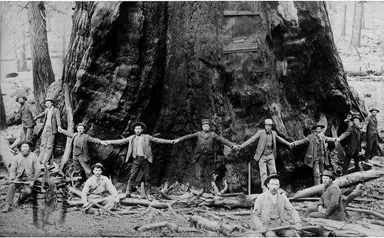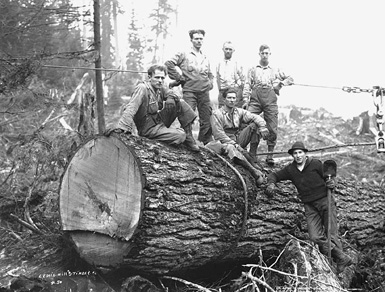Go Straight to Forestry Bibliographies
The Beginnings of the Lumber Industry in Washington State
What agriculture was to eastern Washington, timber was to western Washington. Several California-owned sawmills were built on the Puget Sound in 1853. These sawmills eventually faced competition from Midwestern lumberman, who increasingly migrated west as a result of over-cutting. With westward migration and increasing competition, the lumber industry also became mechanized. Until 1881, oxen dragged logs over greased skid roads and out of the forests. The invention of the steam-powered donkey engine allowed logs to be moved farther, faster, and cheaper by cables. Since neither oxen nor donkey engine could haul logs over long distance, many mills invested in railroad projects to deliver logs efficiently from the interior to mills. (Ficken and LeWarne 1988, 31-38)
Expansion of the Lumber Industry, and Concerns for Conservation
 |
| Men encircling large tree, probably Pacific Northwest, n.d. † |
Beginning in 1905, Washington ranked first in lumber production in the United States for nearly three decades. In 1910, almost two thirds of Washington’s wage earners depended on the lumber industry for their livelihood. (Gates 1948, 216) The expansion of the industry came at great environmental expense. Nineteenth-century logging was exceptionally wasteful. Only prime timber was harvested; the remainder was left on the forest floor to decay and inadvertently nourish forest fires. By 1905, more timber west of the Cascades was destroyed by fire than removed by logging. The potential loss of timber by fires, in turn, promoted rapid cutting regardless of the market conditions to preserve lumber profits. In addition to the grave fire hazards, annual property taxes also encouraged lumbermen to log rather than pay an additional year of taxes. (Ficken and LeWarne 1988, 43-44)
Conservation, therefore, was generally seen as antagonistic to the lumber industry. Some progress was made with the creation of forest reserves. A major natural disaster, the Yacolt Burn of 1902, introduced some forest management measures. The massive burn between Mount St. Helens and the Columbia River, covering 25,000 acres, led lumbermen to lobby governments to cooperate with private landholders to reduce forest fires. Lumbermen also supported the creation of the University of Washington forestry school in 1907. They embraced conservation reforms in the form of fire protection and tax relief, measures that aided their industry and profits. (Ficken and LeWarne 1988, 43-45; Ficken 1987, 127-129)
The Paper and Pulp Industry Re-defines Washington State Lumber
 |
| Choker setters, Lewis Mill and Timber Company, ca. 1922• |
Washington’s pulp and paper industry took root in the Olympic peninsula soon after World War I. The once undesirable hemlock−unsuitable for lumber, but quite suitable for pulp and paper−formed the basis of the new industry. Loggers on the Olympic Peninsula, seeing an opportunity to exploit their tracts of hemlock, quickly invested in the industry. Between 1923 and 1928, pulp and paper plants increased from seven to twenty-one. (Ficken and LeWarne 1988, 98-99; Ficken 1987, 174)
A struggle soon ensued between Port Angeles and Grays Harbor pulp and paper manufacturers−backed by state government officials and foresters from the University of Washington−and the Environment Conservation Committee, created by northeastern environmentalists, over the proposed Olympic National Park. The former charged that the park would sacrifice the peninsula residents’ jobs and investments. After several years of debate, the park was established in 1938, an initial effort in limiting the expansion of the forest industries for the sake of the preservation of forests. (Ficken and LeWarne 1988, 123-125; Ficken 1987, 219-223)
References
Ficken, Robert E. 1987. The Forested Land: A History of Lumbering in Western Washington. Durham, N.C.: Forest History Society; Seattle: University of Washington Press.
Ficken, Robert E., and Charles P. LeWarne. 1988. Washington: A Centennial History. Seattle: University of Washington Press.
Gates, Charles M. 1948. A Historical Sketch of the Economic Development of Washington since Statehood. Pacific Northwest Quarterly vol#: 214-232.
Bibliographies
Forestry Books, 1820-1945 (pdf)
Forestry Journals, 1820-1945 (pdf)
Forestry Theses, 1820-1945 (pdf)
Oregon State College School of Forestry Senior Papers, 1820-1945 (pdf)
Forestry titles filmed by the project (pdf)
†University of Washington Libraries, Special Collections, Negative Number: UW2369.
•University of Washington Libraries, Special Collections, Negative Number: C. Kinsey 1728 .
